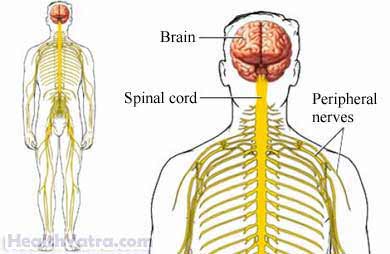Definition
Neurofibromatosis (NF) is a genetic disorder of the nervous system. It causes tumors to grow on the nerves in any part of the body. NF can also produce other problems, such as:
- Changes in skin color
- Deformity of bones

There are three types:
- NF1—caused by mutations (or changes) of the neurofibromin gene (more common)
- NF2—caused by mutations of the merlin gene
- Schwannomatosis—mutation of the SMARCB1/INI1 gene
Causes
NF is caused by a change in a gene. In many cases the abnormal gene is inherited. However, the gene change can occur by chance in a person with no family history of NF. A person with the inherited form of NF has a 50% chance of passing on the abnormal gene each time he or she has a child. Any parents, children, and siblings of an affected individual should be considered at risk for NF.
Risk Factors
The main risk factor for NF is having a family member with the disease.
Symptoms
There are different symptoms for each type of neurofibromatosis. Symptoms can range from mild to severe. In most, the symptoms are mild and may not be noticed.
Symptoms of NF1
Most of these symptoms begin between birth and age 10:
- Light brown spots (called café-au-lait spots) on the skin
- Neurofibromas (tumors that grow on a nerve or nerve tissue)— rarely occur before puberty
- These tumors can progress to become aggressive malignant tumors.
- Freckles in the armpits or groin
- Growths on the iris of the eye (called Lisch nodules or hamartomas)—raised spots on the colored part of the eye
- Tumor on the optic nerve that may affect vision (optic nerve gliomas)
- Severe scoliosis (curved spine)
- Deformed bone in skull or shin bone
- Mild impairment of intellectual function, attention deficit disorder
- Seizures
Symptoms of NF2
- Several tumors on the nerves of the brain and spine. Most common are tumors that affect the nerves to the ears and balance. Hearing loss may begin as early as the teen years.
- Other symptoms may include:
- Tinnitus (ringing in the ear)
- Poor balance
- Headaches
- Pain or numbness in the face
Symptoms of Schwannomatosis
- Pain is primary symptom when tumors are large enough to press on nearby nerves or tissue
- Some may have numbness, tingling, or weakness in fingers and toes
Diagnosis
The doctor will ask about your medical and family medical hisotry. Your doctor will also ask about your symptoms. A physical exam will be done.
The diagnosis is generally made based on your symptoms and the physical exam.
Additional tests may include:
- Exam by a doctor familiar with neurofibromatosis (eg, neurologist, geneticist, dermatologist)
- Eye exam by an ophthalmologist familiar with NF1
- Removal of neurofibromas for testing
- Other specific tests associated with complications
- Magnetic resonance imaging (MRI) scan—for detailed pictures of the brain and body
- Genetic testing—available for families with a history of neurofibromatosis. Prenatal diagnosis may be possible with amniocentesis or chorionic villus sampling.
If you have NF, you will need regular exams to check for:
- Tumors
- Brown spots on the skin
- Bones, including scoliosis
- Hearing
- Vision
Treatment
There are no current treatments to stop these tumors from growing. Treatment may not be needed since these tumors are rarely cancerous, grow slowly and may not cause problems.
For some, treatment may be needed to control symptoms.
Treatment of NF1
Surgery can also be used to remove painful or disfiguring tumors. However, tumors may grow back and in larger numbers. In rare cases when tumors become cancerous, treatment may include:
- Surgery
- Chemotherapy
- Radiation
Surgery can also help to correct some bone problems. Scoliosis may be treated with bone surgery and back braces.
Treatment of NF2
NF2 tumors are evaluated often. MRI scans of the brain can locate tumors when they are small. This allows treatment to be started early before they damage nearby nerves.
Surgery may be done if the tumor becomes too large or effects nearby tissue. It may also be done to try to prevent hearing loss. The tumor can wrap around nerves. Surgery can cause damage to these nerves. If the nerves to the ears are damaged, hearing loss can occur. Other treatment options include:
- Partial removal of tumors
- Radiation
Treatment of Schwannomatosis
Surgery to remove the tumor may help relieve pain.
For some surgery may not be possible. In this case, treatment at a pain clinic may help to manage pain.
Prevention
There are no guidelines for preventing neurofibromatosis.
